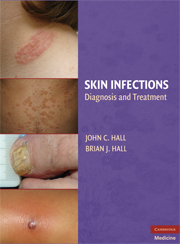Book contents
- Frontmatter
- Contents
- List of Contributors
- Acknowledgments
- INTRODUCTION
- TECHNIQUES IN DIAGNOSING DERMATOLOGIC MANIFESTATIONS OF INFECTIOUS DISEASES
- PRINCIPLES OF MANAGEMENT OF DERMATOLOGIC INFECTIONS IN THE SKIN
- PART 1 COMMON INFECTIONS
- PART II LESS COMMON INFECTIONS
- PART III INFECTIONS IN SELECTED ECOSYSTEMS
- 10 INFECTIONS IN THE DESERT
- 11 INFECTION IN THE TROPICS
- 12 AQUATIC DERMATOLOGY
- PART IV INFECTIONS IN SELECTED PATIENT POPULATIONS
- PART V INFECTIONS OF SPECIFIC SKIN-ASSOCIATED BODY SITES
- PART VI SPECIAL DISEASE CATEGORIES
- Index
12 - AQUATIC DERMATOLOGY
from PART III - INFECTIONS IN SELECTED ECOSYSTEMS
Published online by Cambridge University Press: 08 January 2010
- Frontmatter
- Contents
- List of Contributors
- Acknowledgments
- INTRODUCTION
- TECHNIQUES IN DIAGNOSING DERMATOLOGIC MANIFESTATIONS OF INFECTIOUS DISEASES
- PRINCIPLES OF MANAGEMENT OF DERMATOLOGIC INFECTIONS IN THE SKIN
- PART 1 COMMON INFECTIONS
- PART II LESS COMMON INFECTIONS
- PART III INFECTIONS IN SELECTED ECOSYSTEMS
- 10 INFECTIONS IN THE DESERT
- 11 INFECTION IN THE TROPICS
- 12 AQUATIC DERMATOLOGY
- PART IV INFECTIONS IN SELECTED PATIENT POPULATIONS
- PART V INFECTIONS OF SPECIFIC SKIN-ASSOCIATED BODY SITES
- PART VI SPECIAL DISEASE CATEGORIES
- Index
Summary
HISTORY
The field of aquatic dermatology owes its development both to modern man's extreme mobility around the globe and to a growing attention to skin diseases provoked by the aquatic environment. Aquatic dermatoses are frequently observed in fishermen, scuba divers, sailors, boatmen, bay watchers, swimming pool attendants, swimming instructors, and workers at aquariums, saunas, and Turkish baths, apart from bathers. The different forms of dermatoses can be caused by either biotic or nonbiotic (physical and chemical) agents.
The seas, rivers, lakes, ponds, swimming pools, and aquariums are populated by a myriad of animal and vegetable organisms. During the course of evolution, multitudes of aquatic species have developed both defensive and offensive mechanisms against their predators, in the form of stings and bites that often include a venomous apparatus. These self-protective mechanisms are also used against humans. Many species of marine vertebrates and invertebrates produce biotoxins, most of which serve to capture prey for food (e.g. the toxins produced by Coelenterates). These toxins can also have a simple defense function, like those present on the dorsal spines of the scorpionfish or the spine under the stingray's tail. From a chemical standpoint, the biotoxins identified up to now are amino and phenol derivatives with a low molecular weight, choline esters, or other more complex peptides or proteins. The dermatological manifestations induced by marine organisms can be associated with systemic reactions. These are sometimes of a severe nature leading to shock, and even death.
- Type
- Chapter
- Information
- Skin InfectionsDiagnosis and Treatment, pp. 167 - 182Publisher: Cambridge University PressPrint publication year: 2009
- 7
- Cited by



